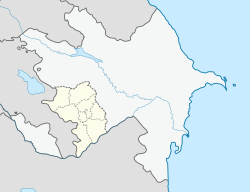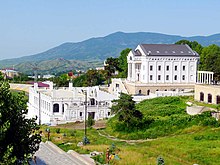Stepanakert
| Stepanakert Ստեփանակերտ Xankəndi |
||
|
||
| Country |
|
|
| Coordinates | 39 ° 49 ′ N , 46 ° 45 ′ E | |
| height | 813 m | |
| surface | 25.66 km² | |
| Residents | 49,300 (2005) | |
| Population density | 1,921.3 inhabitants / km² | |
| Time zone | UTC + 4 | |
| prefix | +374 47 (9) | |
| Website | http://www.stepanakert.am/ | |
|
|
||
Stepanakert ( Armenian Ստեփանակերտ , Russian Степанакерт ) or Azerbaijani Xankəndi is the capital of the Republic of Artsakh , a de facto regime claimed by Azerbaijan in the Caucasus region. The city in the valley of the Karkar (Qarqarçay) has about 50,000 inhabitants.
Surname
In the Middle Ages the city was called Vararakn ( Armenian Վարարակն 'Fast flowing river' ) according to Armenian sources , which is still reminiscent of the name of a small church. In 1847 it was renamed Xankəndi (other transcriptions Xankändi, Khankendi, Chankendi, Chankändi or Hankendi ). The Azerbaijani name Xankəndi is made up of Old Turkish word components. In the Azerbaijani / Turkish language, xan means "Khan" and kənd means "village". The term can thus be interpreted as the “village of the Khan ” and is to be seen in connection with the Karabakh Khanate . With the planned establishment as the regional capital in 1923 in Soviet times, the place was named Stepanakert after Stepan Shahumjan .
history
After the extensive destruction of Nagorno-Karabakh, Shusha , the largest city , as a result of the Shusha pogrom by Turkish and Azerbaijani troops in March 1920, the Soviet power soon afterwards decided to replace the previous village of Vararakn / Xankəndi with a new city as the capital of the city of the Azerbaijani SSR to establish the Nagorno-Karabakh Autonomous Oblast . This was named Stepanakert in 1923 after the Armenian communist Stepan Schahumjan , who was executed by social revolutionaries in Krasnovodsk in 1918 during the Russian civil war . The place grew rapidly, mainly due to the immigration of Armenians from the surrounding villages, and received city rights in 1940.

In the course of the Nagorno-Karabakh conflict , which escalated from 1988, the Nagorno-Karabakh National Council proclaimed the independence of the Nagorno-Karabakh Republic in September 1991 with Stepanakert as its capital. On November 26, Azerbaijan withdrew Nagorno-Karabakh's autonomy status and began firing rockets on Stepanakert. When Shusha was captured on May 9, 1992, the Azerbaijani shelling of the city ended.
The independence of the Nagorno-Karabakh Republic from Azerbaijan has not been recognized internationally. The regional capital is still regarded as belonging to Azerbaijan, which instead of Stepanakert uses the name Xankanndi .
Facilities
The National Assembly , the seats of the President and the Government of the Artsakh Republic are located in Stepanakert.
Stepanakert is now the seat of several universities, including the State University of Artsakh .
Stepanakert Airport , which was renovated by 2011 , but has no air traffic, is located eight kilometers southwest of the city near Chodjali .
Residents
According to Azerbaijani data, the city had 55,000 inhabitants in 2009, according to the local census of 2005 it was 49,300. Almost all Armenians live in the city , the Azerbaijanis have fled because of the conflict.
Churches
Although the majority of Stepanakert's inhabitants belonged to the Armenian Apostolic Church during the Soviet era , there was no church until 2007, because the Georgskirche (Surp Kevork) built at the end of the 19th century was demolished under Josef Stalin in the 1930s to make way for the Stepanakert theater building close.
On the northern outskirts of the city near the military cemetery there is a small medieval church on a piece of private land called Vararakn ( Armenian Վարարակն , German "fast flowing stream"), which has not been used for a long time. It bears the same name as the old Armenian village, in the place of which the Soviet city of Stepanakert was founded.
On May 9th, 2007, the 15th anniversary of the capture of Schuschi , the Jakobskirche (Surp Hakob) was opened. The construction was made possible by the patron Nerses Yepremian from Los Angeles .
Construction of the Cathedral of Our Lady began on July 19, 2006. The construction, initially projected for 2 million US dollars, was financed by its architect, Gagik Yeranosyan. The cathedral was consecrated and opened in 2019.
sons and daughters of the town
- Zori Balajan (* 1935), writer, journalist and sports doctor
- Don Askarian (1949–2018), film producer, director and screenwriter
- Serzh Sargsyan (* 1954), former President of Armenia (2008-2018)
- Robert Kocharyan (* 1954), the first President of the Nagorno-Karabakh Republic, President of Armenia from 1998 to 2008
- Bako Sahakjan (* 1960), Armenian politician in the internationally unrecognized republic of Artsakh
- Karen Karapetjan (* 1963), former Prime Minister of Armenia (2016-2018)
- Andre (* 1979), Armenian singer who represented Armenia at the Eurovision Song Contest 2006
Web links
Individual evidence
- ↑ a b Naira Hayrumyan: I had a dream: A Stepanakert native looks back at Karabakh's recent past. Armenia Now, March 7, 2013.
- ^ A b c Robert H. Hewsen: Armenia: A Historical Atlas. University of Chicago Press, Chicago 2001. p. 265. ISBN 0226332284 , ISBN 9780226332284
- ^ Rau Johannes: The Nagorno-Karabakh conflict between Armenia and Azerbaijan. Publishing house Dr. Köster , 2007, ISBN 978-3-89574-629-1 , p. 34.
- ^ Rau Johannes: The Nagorno-Karabakh conflict between Armenia and Azerbaijan. Publishing house Dr. Köster, 2007, ISBN 978-3-89574-629-1 , pp. 17-18.
- ↑ Eva-Maria Auch : Nagorno Karabakh - War for the "black garden". In: Marie-Carin von Gumppenberg, Udo Steinbach (Ed.): The Caucasus - History-Culture-Politics. Verlag CH Beck, Munich 2010 (2nd edition).
- ↑ Azerbaijan Statistical Agency ( memo of November 14, 2010 in the Internet Archive ).
- ↑ Laura Grigorian: St James Church was opened in Stepanakert. ( April 4, 2012 memento on the Internet Archive ) Armtown, April 4, 2012.
- ^ Stepanakert Church
- ↑ Official ceremony of consecration and opening Cathedral of Intercession takes place in Stepanakert. Retrieved February 17, 2020 .






